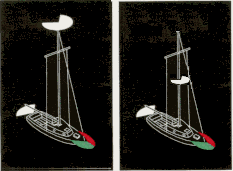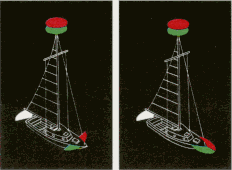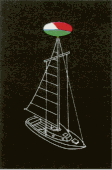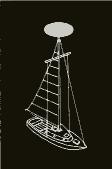Figure 1 |
Power Driven Vessels Power driven vessels of less than 20 meters shall exhibit navigation lights as shown in Figure 1. (Note: 2 masthead lights are optional for vessels under 50 meters. Vessels over 50 meters will display two masthead lights.) Sailing vessels operating under machinery, or under sail and machinery are considered power driven and must display the lights prescribed for a power driven vessel. |
Figure 2 |
Sailing Vessels and Vessels
Under Oars Sailing vessels less than 20 meters may exhibit the navigation lights shown in Figures 2 or 3. |
Figure 3 |
|
Figure 4 |
Another option for sailboats is to use a single combination lantern at the top of the mast as shown in Figure 4. |
| Shapes and
Lights To alert other vessels of conditions which may be hazardous, there are requirements to display lights at night and shapes during the day. |
|
Figure 5 |
Anchored Vessels Vessels at anchor must display anchor lights. An anchor light for a vessel less than 50 meters in length is an all-around white light visible for 2 miles exhibited where it can best be seen (see Figure 5). |
Figure 6 |
Vessels at anchor shall exhibit
forward where best seen, a ball shape (see Figure 6).
Vessels less than 7 meters are not required to display anchor lights or day shapes unless anchored in or near a narrow channel, fairway or anchorage, or where other vessels normally navigate. |
| Anchor lights are not required on vessels less than 20 meters, anchored in special anchorages in inland waters designated by the Secretary of Transportation. | |
Figure 7 |
Sailing Vessels Under Power Vessels under sail also being propelled by machinery, must exhibit forward where best seen, a conical shape with the apex pointing down (see Figure 7). . |
Figure 8 |
Restricted Maneuverability The Navigation Rules require vessels restricted in their ability to maneuver to display appropriate day shapes or lights. To meet this requirement, recreational vessels engaged in diving activities may exhibit a rigid replica of the international code flag "A" not less than one meter in height or at night display the navigation lights shown in Figure 8. |
| This requirement does not affect the use of a red and white divers flag which may be required by state or local law to mark a diver's location. The "A" flag is a navigation signal indicating the vessel's restricted maneuverability and does not pertain to the diver. | |